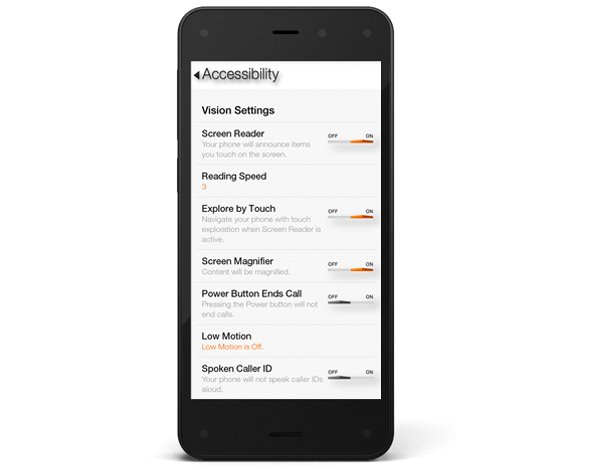by Nubyaan Scott, Program Coordinator for Ability Tools
Many of you may know Amazon for its widely diverse online marketplace where you can buy anything from a squat stand to a Roswell soil sample. But, did you know they also make a smartphone? A couple of weeks ago the company revealed that it had designed its very own Amazon Fire Phone. The phone began shipping on July 25th and is currently only available on AT&T. Most of the articles out around the internet right now have focused on its most unique features: Dynamic Perspective, Firefly technology, and Mayday support.
Dynamic Perspective allows a user to view their screen through a sensor system that responds to how you hold, view, and move your phone. Firefly technology helps you to identify printed web & e-mail addresses, phone numbers, bar codes, movies, TV episodes, songs, and products – all by holding a button down. Finally, Mayday support gives you free, live, on-device video support with an Amazon expert, at any time, by simply touching a button. And, while these features are interesting in their own right, I thought I’d write a little more about the Fire Phone’s accessibility features. The accessibility features are made up of three categories: blind and low vision, hearing, and mobility. The Fire Phone also includes an Accessibility User Guide which provides instructions and tips.
The blind and low vision category features the following settings: screen reader, explore by touch, adjustable reading speed, screen magnifier, high contrast, and spoken caller ID. The screen reader describes the actions that take place on your screen and features IVONA’s natural language voices (listen to examples here http://www.ivona.com/). The explore by touch setting includes a tutorial, and also allows users to explore content by using specific accessibility gestures – meaning the Fire Phone recognizes shortcut gestures that allow a user to access menus and accessibility settings.
The hearing category features closed captioning, hearing aid compatibility, TTY mode, and stereo to mono audio settings. The closed captioning setting lets users watch Amazon Instant Videos and some web videos with Closed Captioning and allows for the style/appearance of Closed Captioning to be adjusted. TTY mode offers full Hearing Carry Over and Voice Carry Over options. And, the stereo to mono audio setting is designed for those who use a single ear bud or who have hearing in one ear.
The mobility category features the following settings: Amazon voice assist, one-handed navigation and shortcuts, and low motion mode. Amazon voice assist features dictation and voice input which allows a user to take notes, send text messages, make phone calls, and more, by just speaking. The one-handed navigation and shortcuts setting includes the following features: tilt, auto-scroll, swivel, peek, and Dynamic Perspective. Tilt lets a user open menu panels by tilting the phone to one side or another. Auto-scroll allows users to scroll the screen from within the browser and some apps, by tilting the phone forward and back. The swivel feature opens the Notifications and Quick Actions panels by swiveling the wrist. The peek setting reveals more information on most screens by slightly tilting the phone. And, low motion mode allows users to turn off the one-handed navigation and shortcuts features, so that the way that you look at and hold your phone will not automatically launch any actions.
Have any of you been able to try out the Amazon Fire Phone and its accessibility features? Let us know what you think!




